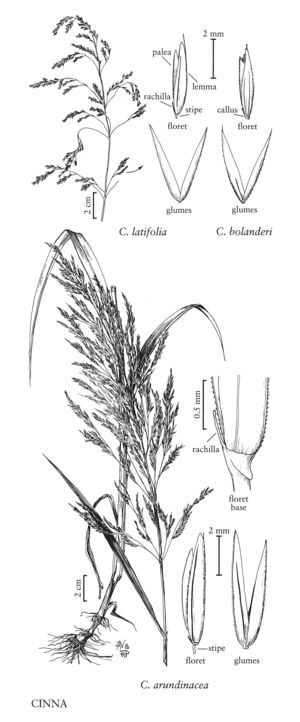Cinna bolanderi
Culms 85-203 cm; nodes 4-8. Ligules 3.5-7 mm; blades to 40 cm long, 2-19 mm wide. Panicles 7.5-43 cm; branches spreading to ascending. Spikelets (3.6) 4-5.5 (6.3) mm; rachilla prolongations 0.4-0.9 mm, sometimes absent. Lower glumes (3.3) 3.5-5.2 (6) mm, 1-veined; upper glumes (3.6) 4-5.5 (6.3) mm, 1-veined or 3-veined; stipes essentially absent, florets more or less sessile; lemmas (2.7) 3.2-4.6 mm, 5-veined, lateral-veins underdeveloped and often faint, awns 0.2-1.5 mm or absent; paleas 2-veined, the veins approximate; anthers 2, 1.2-2.6 mm, rarely to 0.7 mm. Caryopses 2-2.9 mm. 2n = 28.
Discussion
Cinna bolanderi is endemic to meadows and streamsides at 1900-2400 m in Sequoia, Kings Canyon, and Yosemite national parks. It flowers from late summer to fall. It used to be included in C. latifolia, but it differs from that species in having 2 anthers, longer anthers and spikelets, and sessile florets. The two species do not overlap in distribution.
Selected References
None.
Lower Taxa
"decumbent" is not a number.
